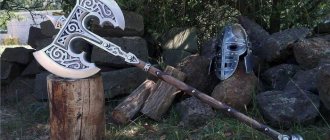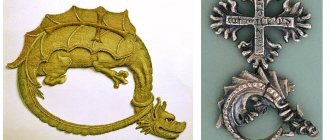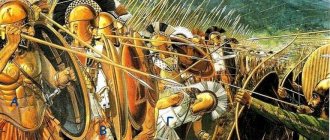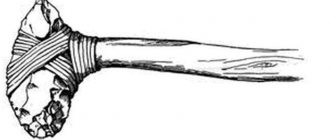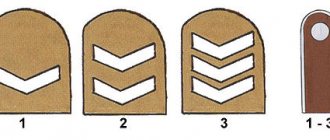Home » Interesting to know » Ax - another battle ax
Publication date: April 23, 2015 at 11:33 am
Ax - another battle ax
Hello, dear readers! Today I would like to continue the topic of “Battle axes” and describe to you about such an example from this series as an ax. Let's talk about its characteristics and functionality. And also about several varieties of axes, common in Asia and Europe.
Types of battle axes
There are many types of weapons in question, they are mainly divided into:
- two-handed (heavy short-shafted axes) and one-handed ax (light);
- double-edged and single-edged.
Double-edged battle axe.
Military weapons are also divided into:
- axes;
- axes;
- halberds;
- mints.
LiveInternetLiveInternet
Eh, I love edged weapons, I can’t help it, they’re so... beautiful.
Battle ax
- multifunctional striking and chopping weapon. Battle axes can be hand- or two-handed, single-sided or double-sided. It was used both for striking and throwing. The wedge can have different shapes and sizes, usually either elongated or increased in width.
The battle ax has become widespread throughout the world, and various modifications of battle axes have appeared in different regions, in particular:
Franziska
- an ax of the Germans and Franks, with a long handle it was a combat ax, with a short handle it was a throwing ax (shorter than the length of an arm), originally the blade was removable.
Brodex
– characterized by a blade extended downwards by 2-3 fingers. One of the favorite weapons of the Vikings.
Labrys
- Ancient Greek, double-sided battle axe.
Egyptian ax:
Sagaris
(
Sagara)
- a double-sided ax - was widely used in the Middle East, states dependent on the Persians and directly in the legendary Persian army. The sagaris had a thin handle, an elongated blade with a heavy butt of a curved or pointed shape. It was a light weapon that could be used by both cavalry and infantry.
Ax
(Slavic. Sikira - sokira - ax) - the birthplace of these axes was Scandinavia, as a result of Norman influence in the 10th-11th centuries they spread throughout Europe and Rus'. A chopping bladed weapon, which is an ax with a wide and long (up to 30 cm) metal blade in the form of a 2-sided crescent. Sometimes there was a hook on the butt to pull the rider off the horse. There are various modifications - the length of the handle is increased, a spike is added, there are many modern versions. By the 16th century in Russia it was embossed with a reed, and in Western Europe - with a halberd and a polex.
Halberd
- piercing and chopping bladed bladed weapon in the form of an ax with an edge. It was in service with the infantry of almost all European countries in the 14th - 16th centuries, and has been preserved as a ceremonial weapon to this day.
Berdysh
— differed from the halberd in having a more elongated blade, sometimes turning into a pike. In the XIV - XVII centuries. in Russia it was in service with streltsy - infantrymen, and also served as a shooting stand.
A halberd and a berdysh were sometimes hung on the wall of noble families crossed:
Polex
- English knightly, battle ax 120-150 cm long.
Types of battle axes:
A battle hatchet (hatchet)
is a chopping bladed weapon. Structurally similar to a battle axe, but smaller in size.
Tomahawk
- a small hatchet of American Indians. Used as a melee weapon and for throwing. At first, tomahawks were made of stone, which was replaced by copper and iron. Sometimes a through hole was drilled in the handle along its entire length, and at the end there was a recess for tobacco. Such tomahawks were used in diplomacy as gifts because they represented a vivid symbol associated with the cultural traditions of the American Indians: on the one hand, a peace pipe, on the other, an ax of war. Tomahawks are divided into three types: Spanish with an ax-shaped tip, French with a diamond-shaped tip, and English with a tip that has a straight blade and a protruding butt.
Japanese cleavers - hatchet knives - suitable for both the kitchen and revenge:
Combat hammer
(warhammer) - cold impact weapon, transformed from a forge hammer. Consists of a long handle and a sledge-shaped tip.
Lucerne hummer
(Lucerne hammer) - a pole weapon in the form of an enlarged weighted hammer, shaped like flames, on a long handle, weight 14 kg.
Mint
- in ancient Rus' the word “chase” was synonymous with the word “axe”. Impact-crushing-chopping polearm bladed weapon, reminiscent in shape of a minting hammer with a beak-shaped blade. A type of war hammer, sharpened on the butt side. Sometimes they were made with a hidden, unscrewing dagger. In the Russian army of the XVI-XVII centuries. the coinage, as a rule, served as a distinctive attribute of the military authorities. A type of mint with a narrow wedge-shaped blade and a hammer-shaped butt, a smaller one is a klevets.
Battle axes
Let's take a look at the most popular types.
- Labrys – was popular during antiquity. This is a double-sided ax that had symmetrical blades.
Brodex axe. - Brodex is a massive Scandinavian ax, an effective weapon for a warrior traveling the earth.
- Sagaris - was popular among the Scythians and their neighbors; it is a small ax with a weighted butt.
- Francis is a weapon of the French and Germans, the only difference is the length of the handle.
Antiquity
Ancient axe.
The Stone Age is the time when the history of battle axes began. It's no secret that it was the stick and stone that became the first tools of ancient man. A stick is a club, a cobblestone is a sharp axe, these are the results of evolution. The important point was the combination of these materials.
Initially, the stone was attached to a stick using improvised means: animal sinews or vines. With such an instrument it was possible to make several blows, but no more. Later, the fastening was carried out through a hole drilled in the stone; such a weapon was also suitable for military purposes.
Bronze Age
Labrys axe.
Greece became a place of prosperity for ancient battle axes, which were made by drilling. There was a special hole inside intended for the handle.
The labrys is a double-headed hatchet that became extremely popular among the Greeks. Quite common are illustrations that depict Zeus, the chief among the gods, with just such a weapon in his hand. There are several groups into which labrys is divided:
- Cult - their volumes were not designed for clashes in battles.
- Combat - the volume was the same as an ordinary hatchet, but the blades were on both sides of the head.
The era of ancient Rome
The Francisca became a famous weapon of that time - its handle was about a meter long and made it possible to fight with one or two hands; it was also used for throwing.
It was used by the Germanic tribe of the Franco, where each warrior had two axes with him, and having a Francis for close combat was an extraordinary joy for a warrior.
Francis' axe.
Vikings
The Vikings, like all peoples, used the battle and working axes. They used different types of head shapes, mostly they were made of steel or iron and had a wedge-shaped cross section. Basically, most people associate Vikings with Brodex.
This is a two-handed axe, however, there were also one-handed ones. The Vikings masterfully wielded these weapons, thanks to which they went down in history.
A formidable Viking with a weapon.
Slavs
Hatchet with gold and silver trim.
This weapon was popular in Rus'; most of them were produced from the ninth to the thirteenth centuries.
Our ancestors borrowed the developments of their neighbors and developed their own, the length did not exceed eight hundred mm, and the weight was no more than five hundred grams. The main materials of the Slavic battle ax are iron and steel.
In our time
M48 is the most popular model from . The axes of this company have different butt options, as well as an impressive appearance. They are not suitable for throwing, as they have a handle made of plastic.
After a few hits they will become unusable. It is recommended to make an ax for yourself with the help of a blacksmith, this way the weapon will fit your hand and be quite reliable.
M48 SOG ax
Characteristics of the ax
The ax consists of a shaft, a blade and a counterweight at the end of the shaft. The ax shaft consists of an ordinary stick, sometimes with a wrapping to prevent your hands from slipping on the shaft. The length of the shaft depends on the method of use: for infantry up to 2.5 meters, “combat halberd”; for cavalry 70 - 80 centimeters, “horse axes”; for boarding ships up to 3 meters, “boarding halberd”.
Battle ax
The warhead was inserted into the eye and secured to the shaft with nails or rivets. The blade of the ax has many types and shapes, but in most cases it looked like a month-shaped blade, not moving far away from the shaft itself.
Since, the further the blade moved away from the shaft, the more the balance of the ax was lost, and, in turn, the possibility of fencing techniques. And if one side is heavier than the other, such an ax will be very difficult to wield.
The use of “butterfly” axes showed that it was difficult to strike with such an ax; the ax itself was very heavy and upon impact there was a very large inertial force. There were also axes where the blade exceeded the shaft itself and served as a counterweight to itself.
Often the front part of the blade was sharpened so that it was possible to deliver piercing blows, although in several types of axes a kind of spike is used for this. Very often, between the blade and the spike or the blade and the shaft there is a gap, which is used to capture the opponent’s blade, but for this you need to be fluent in the fencing techniques of the axe.
On the opposite side of the blade, where the butt is located, some types of axes use a hook. It is used for various purposes, such as: grabbing the wall or side of a ship, throwing a rider off a horse, and much more.
The cutting part of the ax varies in length from 10 centimeters to a blade equal in length to a sword-shaped blade. At the bottom of the ax blade there is a protrusion, below the fastening point itself, it is called a scythe and is used for better fastening of the blade itself to the shaft.
The counterweight was a simple metal knob or spike that was used to push into the ground, but it could also be used to deliver a discreet blow. Without a counterweight, the ax would be very difficult to handle.
Ax functionality
Multifunctionality of the ax
The functionality of the ax allows you to use it as a spear, the difference between them is only in length, and of course the balance will not allow you to throw the ax like a spear. In a one-on-one fight, the ax has many advantages over other types of melee weapons.
An ax can be used to pull a warrior off a horse or to strike at the lower limbs unprotected by a shield. If, for example, spears were used in defense, axes and swords in attack, then axes were the golden mean between them. Although many armies used detachments of ax-bearers to protect the flanks, using pikemen in the center.
Read on "E-KLAD": Celtic ax - combat or ordinary hard worker
On graves and coats of arms
In addition to war and tournaments, pollex was also used during the “God's Judgment” - a duel in which the winner was cleared of all charges. And there is one rule associated with this kind of battles, which the tombstone makers knew very well. )))
So, if the justified winner nevertheless died from the wounds received during God’s judgment, then on the grave monument he was depicted dressed in exactly the armor in which he cleared his name from accusations. The statue was supposed to hold a sword and an ax in crossed hands. The one who was killed in a duel was depicted as fully armored and also with his arms crossed. However, all of his offensive weapons were depicted next to him.
Among other things, battle axes were an honorary coat of arms. They can be seen on the coats of arms of Norway, France, on the historical coat of arms of the King of Iceland and on the modern coat of arms of the Swiss canton of Saint Gall.
Coat of arms of Norway
It was the ax that helped the rootless Moravian Wieniawa, a simple stoker, receive nobility, a coat of arms and large estates. The family legend of the Perenstein family tells how the big man Wieniawa managed to catch a wild bison and brought it straight to the royal court. Where, in front of the astonished king, he took off the head of a bison with an ax with one blow. The delighted monarch immediately made him a rich man. This story is described in more detail in the article “Three legends about the coats of arms of knights (part 1, 2)“
